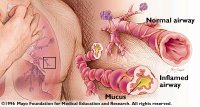About dust & dust mites and asthma
Dust is an unavoidable part of life. Practically every activity in life generates dust. A human sitting at rest generates 100,000 dust particles per cubic foot of air every minute. The act of walking generates another 10 million particles per cubic foot of air every minute.
Household dust contains tiny particles of pollen, mold, fabric fibers, dander and dust mites. Dust can produce symptoms in individuals who are allergic to any of these allergens. However, dust mites are the source of most dust allergies.
Relatives of the spider, dust mites are microscopic arachnids one-third of a millimeter long that live indoors in household dust. Between 100 and 500 dust mites typically inhabit a single gram of dust, though in some cases the number can soar to 19,000.
Dust mites do not bite, spread disease or actually live on humans. However, dust mite feces contain a protein that is a powerful allergy trigger for many people. Each mite produces waste that is up to 200 times its body weight. Over time, the waste dries up and turns to powder, allowing it to become airborne. When an allergic person inhales the powder, an allergic reaction or asthma attack often follows. According to the Asthma and Allergy Foundation of America, about 20 million Americans are allergic to dust mites. The allergen is one of the most common causes of year-round allergy and asthma symptoms.
Dust mites are tough to eliminate because they have pads at the ends of their legs that allow them to firmly attach to the fibers in carpeting, upholstery and mattresses. They are found in great quantities in the bedroom, where they feed off the dead skin cells that people constantly shed. The average adult sheds enough skin each day to feed one million dust mites.
House dust mite populations tend to be smaller in areas at higher elevations (e.g., Rocky Mountain states), mostly due to the lack of moisture in these regions. Exposure to low humidity levels or extreme temperatures will kill most dust mites.
Dust springs from almost every corner of life. Matter that disintegrates eventually reduces to the particles that end up in dust, which can then become airborne. Many common allergens find their way into household dust, including:
*
Molds
*
Cockroach debris
*
Dead dust mite debris
*
Tobacco smoke and its toxic byproducts
*
Fibers
*
Food particles
*
Pollens
*
Plant and insect parts
*
Hair, animal fur and feathers
*
Dried pet saliva or urine
*
Flakes of human skin and animal dander
Dust mites are microorganisms that thrive in settings where moisture and dust are abundant. In the United States, dust mite populations tend to peak in the warm, humid weather months. However, their fecal allergens remain present at high levels for months afterward, into early winter and beyond. Dust mites tend to congregate in the following areas:
*
Mattresses and box springs
*
Drapes and curtains
*
Bed sheets, comforters, canopies and ruffles
*
Clothing
*
Upholstered furniture














0 Comments:
Post a Comment
<< Home